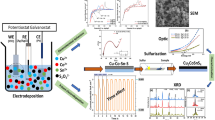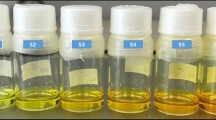Abstract
Cu2FeSnS4 (CFTS) is a quaternary chalcogenide semiconducting nanomaterial which shows promising features for optoelectronic applications. In the present study, the hydrothermal method was employed to synthesize CFTS nanoparticles using metal–diethyldithiocarbamate and the regularly reported chloride as precursors. From the nanoparticles, thin films were prepared by spin coating, and annealed in sulfur atmosphere. The effect of precursor material on CFTS properties, particularly in the photoresponse, was investigated by spectroscopic and microscopic techniques. Diethyldithiocarbamate route produced single phase, crystalline CFTS nanoparticles were 15–20 nm. The perfect crystalline nature of CFTS nanoparticles was analyzed by HRTEM. The optical absorption spectrum shows strong absorption with an ideal optical band gap which is suitable for solar cell applications and Photoresponse behavior of CFTS thin film was documented. This work contributes to a deeper understanding of the relationship between precursor selection, nanoparticle properties, and photoresponse characteristics, paving the way for enhanced design and utilization of Cu2FeSnS4 nanoparticles in photodetectors and other optoelectronic devices.











Similar content being viewed by others
Data availability
The authors affirm that the data supporting the findings of this study are available within the article.
References
M.A. Green, Third generation photovoltaics: solar cells for 2020 and beyond. Physica E 14(1–2), 65–70 (2002)
V. Zardetto, B.L. Williams, A. Perrotta, F. Di Giacomo, M.A. Verheijen, R. Andriessen, W.M.M. Kessels, M. Creatore, Atomic layer deposition for perovskite solar cells: research status, opportunities and challenges. Sustain. Energy Fuels 1(1), 30–55 (2017)
M.A. Green, A. Ho-Baillie, H.J. Snaith, The emergence of perovskite solar cells. Nat. Photonics 8(7), 506–514 (2014)
J.-P. Correa-Baena, M. Saliba, T. Buonassisi, M. Grätzel, A. Abate, W. Tress, A. Hagfeldt, Promises and challenges of perovskite solar cells. Science 358(6364), 739–744 (2017)
S.A. Shah, Z. Guo, M.H. Sayyad, J. Sun, Application of mxenes in perovskite solar cells: a short review. Nanomaterials 11(8), 2151 (2021)
M. Paire, S. Delbos, J. Vidal, N. Naghavi, J.F. Guillemoles, Chalcogenide thin-film solar cells. Solar Cell Mater. 7, 145–215 (2014)
W. Li, J.M.R. Tan, S.W. Leow, S. Lie, S. Magdassi, L.H. Wong, Recent progress in solution-processed copper-chalcogenide thin-film solar cells. Energy Technol. 6(1), 46–59 (2018)
V. Kheraj, K.K. Patel, S.J. Patel, D.V. Shah, Synthesis and characterisation of copper zinc tin sulphide (CZTS) compound for absorber material in solar-cells. J. Cryst. Growth 362, 174–177 (2013)
K. Ramasamy, M.A. Malik, P. O’Brien, Routes to copper zinc tin sulfide Cu 2 ZnSnS 4 a potential material for solar cells. Chem. Commun. 48(46), 5703–5714 (2012)
H. Yang, L.A. Jauregui, G. Zhang, Y.P. Chen, Wu. Yue, Nontoxic and abundant copper zinc tin sulfide nanocrystals for potential high-temperature thermoelectric energy harvesting. Nano Lett. 12(2), 540–545 (2012)
M.A. Olgar, Enhancement in photovoltaic performance of CZTS Thin-film solar cells through varying stacking order and sulfurization time. J. Mater. Sci. 33(25), 20121–20133 (2022)
G.S. Babu, X.S. Shajan, A. George, P. Parameswaran, S. Murugesan, R. Divakar, E. Mohandas, S. Kumaresan, G.M. Rao, Low-cost hydrothermal synthesis and characterization of pentanary Cu2ZnxNi1− xSnS4 nanoparticle inks for thin film solar cell applications. Mater. Sci. Semicond. Process. 63, 127–136 (2017)
R. Ahmad, N.-u-H. Saddiqi, Wu. Mingjian, M. Prato, E. Spiecker, W. Peukert, M. Distaso, Effect of the counteranion on the formation pathway of Cu2ZnSnS4 (CZTS) nanoparticles under solvothermal conditions. Inorg. Chem. 59(3), 1973–1984 (2020)
F.-J. Fan, Wu. Liang, Yu. Shu-Hong, Energetic I-III–VI 2 and I 2–II–IV–VI 4 nanocrystals: synthesis, photovoltaic and thermoelectric applications. Energy Environ. Sci. 7(1), 190–208 (2014)
B.M. Sperry, N.A. Kukhta, Y. Huang, C.K. Luscombe, Ligand decomposition during nanoparticle synthesis: influence of ligand structure and precursor selection. Chem. Mater. 35(2), 570–583 (2023)
S.D. Deshmukh, R.G. Ellis, D.S. Sutandar, D.J. Rokke, R. Agrawal, Versatile colloidal syntheses of metal chalcogenide nanoparticles from elemental precursors using amine-thiol chemistry. Chem. Mater. 31(21), 9087–9097 (2019)
D.S. Dhawale, A. Ali, A.C. Lokhande, Impact of various dopant elements on the properties of kesterite compounds for solar cell applications: a status review. Sustain. Energy Fuels 3(6), 1365–1383 (2019)
S.A. Vanalakar, P.S. Patil, J.H. Kim, Recent advances in synthesis of Cu2FeSnS4 materials for solar cell applications: a review. Sol. Energy Mater. Sol. Cells 182, 204–219 (2018)
C. Nefzi, M. Souli, Y. Cuminal, N. Kamoun-Turki, Effect of sulfur concentration on structural, optical and electrical properties of Cu2FeSnS4 thin films for solar cells and photocatalysis applications. Superlattices Microstruct. 124, 17–29 (2018)
C. Dong, G.Y. Ashebir, J. Qi, J. Chen, Z. Wan, W. Chen, M. Wang, Solution-processed Cu2FeSnS4 thin films for photovoltaic application. Mater. Lett. 214, 287–289 (2018)
V.S. Ghemud, P.R. Jadhav, P.T. Kolhe, P.N. Shelke, S.S. Dahiwale, A. Kshirsagar, Experimental and computational study of Cu2FeSnS4: An emerging quaternary semiconductor. Opt. Mater. 142, 114123 (2023)
H. Oueslati, M. Ben Rabeh, M. Kanzari, Growth and characterization of the evaporated quaternary absorber Cu2FeSnS4 for Solar cell applications. J. Electron. Mater. 47, 3577–3584 (2018)
S. Chatterjee, A.J. Pal, A solution approach to p-type Cu2FeSnS4 thin-films and pn-junction solar cells: role of electron selective materials on their performance. Sol. Energy Mater. Sol. Cells 160, 233–240 (2017)
M.D. Regulacio, N. Tomson, S.L. Stoll, Dithiocarbamate precursors for rare-earth sulfides. Chem. Mater. 17(12), 3114–3121 (2005)
C. Sambathkumar, N. Nallamuthu, M.K. Kumar, S. Sudhahar, P. Devendran, Electrochemical exploration of cobalt sulfide nanoparticles synthesis using cobalt diethyldithiocarbamate as single source precursor for hybrid supercapacitor device. J. Alloys Compd. 920, 165839 (2022)
G.O. Siqueira, T. Matencio, H.V. da Silva, Y.G. de Souza, J.D. Ardisson, G.M. de Lima, P.A. de Oliveira, Temperature and time dependence on ZnS microstructure and phases obtained through hydrothermal decomposition of diethyldithiocarbamate complexes. Phys. Chem. Chem. Phys. 15(18), 6796–6803 (2013)
P. Devendran, T. Alagesan, T.R. Ravindran, K. Pandian, Synthesis of spherical CdS quantum dots using cadmium diethyldithiocarbamate as single source precursor in olive oil medium. Curr. Nanosci. 10(2), 302–307 (2014)
R.R. Prabhakar, N. Huu Loc, M.H. Kumar, P.P. Boix, S. Juan, R.A. John, S.K. Batabyal, L.H. Wong, Facile water-based spray pyrolysis of earth-abundant Cu2FeSnS4 thin films as an efficient counter electrode in dye-sensitized solar cells. ACS Appl. Mater. Interfaces 6(20), 17661–17667 (2014)
K. Mokurala, S. Mallick, P. Bhargava, Alternative quaternary chalcopyrite sulfides (Cu2FeSnS4 and Cu2CoSnS4) as electrocatalyst materials for counter electrodes in dye-sensitized solar cells. J. Power. Sources 305, 134–143 (2016)
C. Nefzi, M. Souli, Y. Cuminal, N. Kamoun-Turki, Effect of substrate temperature on physical properties of Cu2FeSnS4 thin films for photocatalysis applications. Mater. Sci. Eng. B 254, 114509 (2020)
N. Mukurala, R.K. Mishra, S.H. Jin, A.K. Kushwaha, Sulphur precursor dependent crystallinity and optical properties of solution grown Cu2FeSnS4 particles. Materials Research Express 6(8), 085099 (2019)
R. Deepika, P. Meena, Colloidal chemical synthesis of quaternary semiconductor Cu2FeSnS4 (CFTS) nanoparticles: absorber materials for thin-film photovoltaic applications. J. Mater. Sci. 34(1), 16 (2023)
A.C. Ji, X.C. Xie, W.M. Liu, Quantum magnetic dynamics of polarized light in arrays of microcavities. Phys. Rev. Lett. 99(18), 183602 (2007)
Acknowledgements
GSDB acknowledges the Management of Chettinad College of Engineering and Technology Management, Karur for the support to carry out research work. A portion of this research was performed using facilities at Centre for Nanoscience and Engineering (CeNSE), Indian Institute of Science, Bangalore through Indian Nano User Programme (INUP), funded by Department of Electronics and Information Technology (DeitY), Govt. of India. Special thanks to Dr. Gopal MB, UGC-DAE-CSR, Kalpakkam for TEM analysis and discussions. A part of research work was carried at UGC-DAE Consortium for Scientific Research, Kalpakkam Node, Kokkilamedu, India.
Funding
This research received no specific grant from any funding agency in the public, commercial, or not-for-profit sectors.
Author information
Authors and Affiliations
Contributions
SDB: worked in the laboratory for experimental work, wrote the manuscript, development or design of methodology, creation of models and XSS: Project administration, supervision review and editing of manuscript. Each authors have knowledge about their submission and contributed work equally.
Corresponding author
Ethics declarations
Competing interest
The authors affirm that they have no known financial or interpersonal conflicts that would have appeared to have an impact on the research presented in this study.
Human and animal rights
All experiments in this study were not involved with human subjects or animals were not performed in accordance with the ethical standards of the institution at which the studies were conducted.
Additional information
Publisher's Note
Springer Nature remains neutral with regard to jurisdictional claims in published maps and institutional affiliations.
Rights and permissions
Springer Nature or its licensor (e.g. a society or other partner) holds exclusive rights to this article under a publishing agreement with the author(s) or other rightsholder(s); author self-archiving of the accepted manuscript version of this article is solely governed by the terms of such publishing agreement and applicable law.
About this article
Cite this article
Babu, G.S.D., Shajan, X.S. Photoresponse analysis of hydrothermally synthesized p-type Cu2FeSnS4 nanoparticles using metal-diethyldithiocarbamate precursors. J Mater Sci: Mater Electron 34, 2286 (2023). https://doi.org/10.1007/s10854-023-11692-0
Received:
Accepted:
Published:
DOI: https://doi.org/10.1007/s10854-023-11692-0




